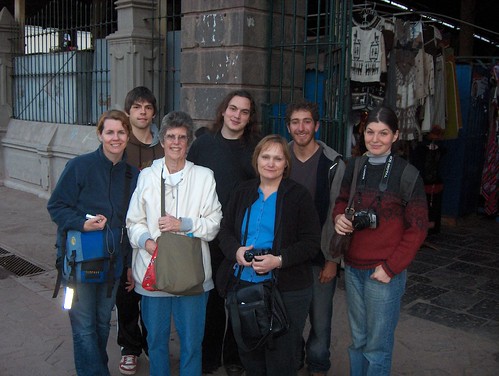Real city tour of Cusco
This afternoon, Juan Carlos took a gang of us Amigos students on what he calls a "real city tour" of Cusco. The sites on the tour are all various places where the poorer, less advantaged people of Cusco live, work, and study. Definitely not your average city tour. And after completing it, it became inescapably obvious to me that the tourist-infested city centre — the only area I really knew, up until now — is definitely not the real Cusco.
First stop was the Revolucionaria Santa Rosa school, a primaria and secundaria (former from 8am-1pm, latter from 1pm-6pm) in a lower-class neighbourhood of Cusco. The kids there seemed happy enough and taken care of; but Juan Carlos explained how many of them are poor kids from the mountains, who have to work and find boarding whenever they're not at school, because they have no schools where they live. He also explained how competitive it is to get into Cusco's sole government university, and how most students fail to obtain a place in tertiary education.

“Revolucionaria Santa Rosa” kids having a PE (Physical Education) lesson.
Next was a place where adobes (mud bricks) are made and sold. Here in Peru, brick-making is all still manual labour. Workers mix dirt, water, and soil by stepping around a mud pit with their bare feet, all day long. Then, the mud is hand-shaped into hundreds of bricks each day, which are then left to dry. The workers here all work long hours, they all have families to support, and they each get a mere s/10 a day.

Adobe brick worker fashioning a fresh brick.
The highlight, and really the most shocking part of the tour, was the visit to a chicheria. In the poorer neighbourhoods, the traditional Peruvian drink chicha is extremely cheap — s/0.30 for a schooner-sized cup — and is quite strong. At the chicheria we went to, there were some serious alcoholics staggering around outside, hassling us a bit, and clearly the victims of prolonged over-drinking of chicha. In the area, alcoholism — and associated problems, such as theft and domestic violence — is extremely prevalent. We did of course try some chicha while we were there.

The stone oven used to make chicha in the chicheria.
Then there was Casa de Gladys, a small house near the chicheria, inhabited by a runaway abused wife and her several children (none of whom were anywhere to be seen). The house was similar to the one I stayed in when I got lost near Cusco last weekend, only worse. The whole family sleeps, eats, and cooks in one dirty, cluttered little room. There were beds, animals, and piles of junk everywhere. Not the most appealing place to live; but that's how life is in the slums of Cusco. The slums of Lima are probably much worse.

The back yard of Casa de Gladys.
Our second-to-last stop was the frutillada shop — a place that serves a more upmarket fruit-juice-mixed chicha drink, and that contrasts starkly with a chicheria.

Chilling over a frutillada drink.
And our final stop was the San Pedro market, where I bought the ingredients of my pasta of death a few days ago. San Pedro is Cusco's biggest market, and its workers open shop at 4am each morning, and are forced by competition to sell their produce in bulk at extremely low prices (except to gringos, of course!). Chaotic place, and they have everything there.

End of the tour, outside the San Pedro market. People (left-to-right): Amy, Will, Ann, Louis, Chrystal, myself, and Monika.
